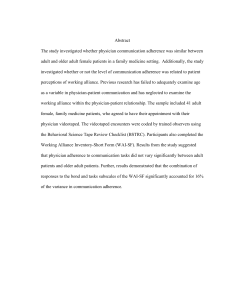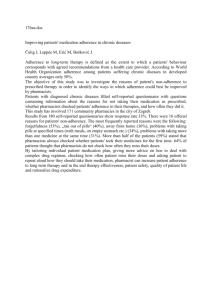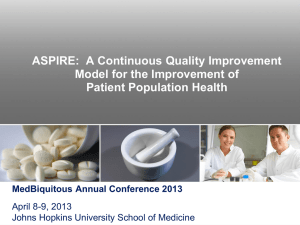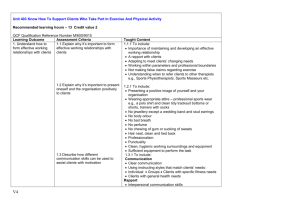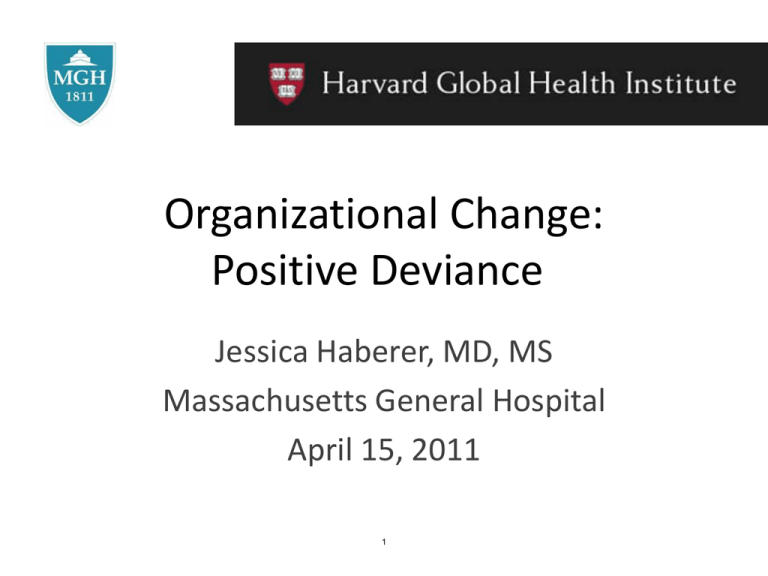
Organizational Change:
Positive Deviance
Jessica Haberer, MD, MS
Massachusetts General Hospital
April 15, 2011
1
I have no conflicts of interest to
declare
2
Outline
• Objective: Understand how to design and
lead systems changes to achieve quality
improvement within a heath care
organization
---------------- delivery program
• Review the concept of positive deviance
• Focus on adherence to antiretroviral therapy
(ART)
• Present my experience in sub-Saharan Africa
3
Holy Grail of quality improvement
• Is there an innovative approach that can
promote and sustain behavioral or cultural
change that is
– More people-driven
– More sustainable
– Less resource-intensive?
4
Positive Deviance
• Behavior and social change strategy
• Based on the observations of nutrition
professor Marian Zeitlin
• There are well-nourished kids even among the
poorest communities: “positive deviants”
• Identify what these families are doing right
and amplify it rather than fixing what’s wrong
with the community
5
Positive Deviance
• Save the Children’s Jerry and Monique Sternin
operationalized the concept as a tool to
promote behavior and social change
• Problem: >65% of Vietnamese
children are malnourished
• Traditional supplemental feeding
programs unable to sustain weight gains after
the programs ended
6
Positive Deviance
• Sternins sat with families to learn from them
through discussions and observations
• Process
– Enabled the community to define the problem
– Uncovered current attitudes and feeding
behaviors
7
Positive Deviance
• Villagers created their own growth charts and
“discovered” well-nourished kids among them
• Parents kept these kids well-fed through
“unusual” behaviors:
– Went out to rice paddies every morning to gather
fresh water shrimp, crabs and sweet potato
greens
– These foods were abundant but misconceived by
the community to be inappropriate for young
children
8
Positive Deviance
• Sternins encouraged villagers to design a plan
to enable families with malnourished kids to
learn the new practices
• Learning and resource families went to rice
paddies, prepared meals and fed their kids
together
“It is easier to act your way to
a new way of thinking than to
think your way to a new way of
acting.”
9
Positive Deviance
• Sustained 65-80% reduction in childhood
malnutrition in Vietnamese communities
• Increase in primary school student retention in
Missiones, Argentina
• Reduction in girl trafficking in East Java, Indonesia
• Decrease in neonatal deaths and sickness in
Pashtun, Pakistan
• VA Pittsburgh Healthcare System to scale
initiative to reduce MRSA
10
Positive Deviance
Step 1: Identify positive deviants
Step 2: Use qualitative methods to generate
hypotheses on achieving top performance
Step 3: Test hypotheses in larger,
representative samples
Step 4: Work with key stakeholders
to disseminate best practices
Bradley et al, Implementation Science, 2009
11
Adherence to ART
• HIV can be fully suppressed with highly active
antiretroviral therapy (3-drug regimen)
• Lapses in adherence may allow the virus to
start replicating again
• In the presence of sub-therapeutic levels of
drug, drug resistance and ultimately
treatment failure will develop
• Good adherence is therefore really important
12
Fears of poor adherence
• Will widespread, unregulated access to antiretroviral drugs in
sub-Saharan Africa, lead to the rapid emergence of drug
resistant viral strains, spelling doom for the individual,
curtailing future treatment options, and [leading] to
transmission of resistant virus?”
Harries et al, Lancet, 2001
• [In sub-Saharan Africa]….the potential short term gains from
reducing individual morbidity and mortality may be far
outweighed by the potential for the long term spread of drug
resistance…. In Africa, a higher proportion of patients are likely
to fall into the category of potential poor adherers unless
resource intensive adherence programmes are available.
13
Stevens et al, BMJ, 2004
More fear… and prejudice?
Africans “don’t know what Western time
is,”and “do not know what you are talking
about,” when asked to take drugs at
specific times.
Andrew Natsios, USAID Administrator, 2001
14
Adherence to ART in the US
San Francisco
67%
Bangsberg, AIDS, 2000
Pittsburgh
74%
Paterson, Annals Int Med, 2000
Los Angeles
63%
Liu, Annals Int Med, 2001
New York City
57%
Arnsten, CID, 2001
Hartford
53%
McNabb, CID, 2001
Philadelphia
79%
Gross, AIDS, 2001
15
Adherence in patients
purchasing generic ART in
Uganda
(N=36)
MEMS
Unannounced
pill count
Self-report
93%
(SD 16%)
92%
(SD 16%)
94%
(SD 16%)
Oyugi et al, JAIDS, 2004
16
Meta-analysis of barriers to adherence
in developed and developing settings
• Systematic review of adherence
– 28,689 patients in 228 studies
• North America
• Brazil, Uganda, Cote d’Ivoire, South Africa, Malawi,
Botswana, Costa Rica, Romania
– Achieved >95% adherence
• Developed countries: 55% (95% CI: 48-61%)
• Developing countries: 77% (95% CI: 67%-86%)
17
Mills et al, JAMA, 2006
Adherence over 12 months on free
ART in Mbarara, Uganda (N=274)
Graph removed due to copyright restrictions. Results show ~95% medication
adherence over a 12-month period, but self-reports show 100% adherence.
Bangsberg, CROI, 2008
18
Step 1: Identify
positive deviants
Step 2: Use qualitative
methods to generate
hypotheses on achieving
top performance
© New York Times. All rights reserved. This content is
excluded fromour Creative Commons license. For more
information, see http://ocw.mit.edu/fairuse.
19
A social model of adherence for sub-Saharan Africa
Improving Health
Resource
Scarcity
Relationships
as resources to
overcome
economic
obstacles to
adherence
Social
Capital
Adherence
fulfills
responsibility to
helpers and
preserve
relationships
as a resource
Resource
Scarcity
20
Ware, PLoS Med, 2009
A social model of adherence for sub-Saharan Africa
Improving Health
Individual:
HIV knowledge
Med side effects
Cognitive function
Mental health
Alcohol Use
Social Structural:
Patterns of inequality,
e.g., stigma,
gender inequality
Resource
Scarcity
Relationships
as resources to
overcome
economic
obstacles to
adherence
Social
Capital
Adherence
fulfills
responsibility to
helpers and
preserve
relationships
as a resource
Resource
Scarcity
Cultural:
Religious Beliefs
Respect for Authority
Importance of
having children
Infrastructural:
Few treatment sites
Distance to care
Cost/availability of
transportation
21
Ware, PLoS Med, 2009
Triomune
D4T/3TC/Nevirapine
$17 USD per month
22
How to take ART on time in rural Uganda
without a watch: John’s adherence story
• No education
• Works as a farmer
• Lives with his brother, sister-in-law, and 3 nieces
in a 3 room mud-walled house without electricity
• Owns a lantern, bed, sofa, bike, and a radio, but
no watch.
• HIV in April 2005 and started generic ART
(Triomune) after disseminated herpes zoster and
Kaposi’s sarcoma
• CD4 count of 151
Maier, PLOS, 2006
23
Electronic medication monitor record (MEMS)
of bottle openings for AM and PM doses
Graph showing data points over time removed due to copyright restrictions.
24
John’s adherence
• 90% of doses within 10 minutes of 7:20 pm
• 90% of doses within 17 minutes of 7:20 pm
• Overall adherence: 99%
25
Maier, et al. "How to Take HIV Antiretroviral Medications on Time
without a Watch in Rural Uganda." PLoS Medicine 3(3) (2006).
26
John’s Adherence: 0-9 and 10-18 months
Subsequent MEMS assessment (May
2006 to January 2007 (9 months)
Initial MEMS assessment (August 2005
to April 2006 (9 months)
27
Deceptively good adherence
• Median adherence levels may mask transient
adherence lapses
• Cohort of children taking ART in rural Uganda
– Median adherence: 94-100% by multiple
measures
– Percent with viral suppression: 47%
• Transient adherence lapses may result in drug
resistance to 1-2 drugs that will eventually
result in treatment failure
28
Haberer et al, in preparation, 2011
Key barriers to good adherence
Individual:
HIV knowledge
Med side effects
Cognitive function
Mental health
Alcohol Use
Social Structural:
Patterns of inequality,
e.g., stigma,
gender inequality
Cultural:
Religious Beliefs
Respect for Authority
Importance of
having children
Infrastructural:
Few treatment sites
Distance to care
Cost/availability of
transportation
29
How to extend good adherence
• Identify those people with adherence
problems and intervene before the clinical
consequences develop
• The window of opportunity is short, as viral
replication likely begins within 48 hours of an
adherence lapse
• Real-time adherence monitoring and
intervention is needed…
enter technology!
30
Types of adherence monitoring
• Subjective
– Structured patient interview (a.k.a. self-report)
– Various recall periods (e.g. last 7 days)
– Number of doses missed/taken, rating, frequency
– Visual analog scales
0%----------------50%--------------100%
– In person, by audio computer assisted selfinterview (ACASI)
– Quick, easy, and cheap, but tend to overestimate
true adherence
31
Types of adherence monitoring
• Objective
– Clinic and home-based pill counts
– Pharmacy refill
– Electronic monitors (e.g. MEMS caps)
– Drug levels (blood, hair, urine)
– More likely to be accurate, but
more expensive and still imperfect
32
Methods for self-report
by mobile phones
• Types
– Live calls: flexible for detailed data collection
– Interactive voice response (IVR): great for low literacy
– Text messaging (SMS): popular and convenient
• Key features
– Involves 2-way communication (i.e. not just
reminders)
– Data source may be the patient or a community
health worker
33
Limitations
• Subject to network availability
• Patients may share phones, change numbers,
turn off or not power their phones
• Requires some technology infrastructure and
expense
• Dependent on patient understanding and
motivation
34
Data from rural Uganda
Map showing locations of Kampala and Mbarara in
Uganda removed due to copyright restrictions.
•
•
•
•
•
49 adults, 46 caregivers of children 2-10 yrs
Weekly adherence queries
Expected response: PIN -> # HIV meds missed
Multiple attempts per week
Participants given phones, received training
with “just in time” support
35
The participant’s experience
• “At first those questions confused me. They would ask
you for your year. You would still be trying to respond
and the call goes off. Then, they say that we shall try
to call you back. Yet, the person who had trained me
had repeated for me and told me what to do. It really
greatly disturbed me. They were hard.”
• “Well, for the first time I had forgotten what to do, and
when trying to click yes the call went off. They came
and trained me again and I learnt that when the call
comes and you respond, you don’t first erase, because
when I would try doing so the call would go off.”
36
Wireless pill containers
WisepillTM
•
•
•
•
Courtesy of Wisepill Technologies. Used with permission.
Signal sent over cellular network when device opened
Daily signal to confirm battery and device functionality
Flash memory to send signals if travel out of network
Data transmitted to a server by general packet radio
service (GPRS) with back up SMS
37
Data from rural Uganda
• 49 adults and 46 children aged 2-10
• 48+ hour adherence interruptions
assessed by interview
• HIV RNA determined every 3
months and during interruptions
38
Results
• High acceptability
• Adults: median adherence 92% (IQR 83%-97%) with 45
interruptions
• Children: median adherence 97% (IQR 89%-100%) with 19
interruptions
• Causes of 48+ hour interruptions:
– 17 due to forgot doses, intentional non-dosing, pocket
doses, hospitalizations, unexpected travel, new
caregivers
– 42 interruptions had no clear cause (likely behavioral)
• Wisepill data correlated with HIV RNA suppression (r=0.44,
p=0.01)
• New viral rebound detected in 15% of interruptions
39
Step 3: Test hypotheses in larger,
representative samples
• We are currently expanding this pilot work in
a cohort of ~500 adults
– Looking at social support, stigma
– Data will be used to design real-time adherence
interventions
– Experience with cell phones will be used to
automate linkages to enhanced support
40
Other ongoing studies in Mbarara
• Examination of social capital for propagation
of adherence behavior, treatment of
depression (Christakis, Rosenquist)
• Role of food security (Weiser)
• Role of transportation cash transfers
(Emenyonu, Bangsberg)
• Factors of fertility desire (Matthews, Kaida)
41
SMS reminders improve ART
adherence and viral suppression (N=538)
• RCT of weekly SMS reminders vs controls in Kenya
• Adherence by self-report
– Relative risk of non-adherence: 0.81 (95% CI 0.69-0.94;
p=0·006)
– # Needed to treat >95% adherence: 9 (95% CI 5.0-29.5)
• Virologic failure
- Relative risk: 0.84 (95% CI 0.71-0.99; p=0·04)
– # Needed to treat: 11 (95% CI 5.8-227.3)
Lester, Lancet, 2010
42
Type of SMS reminder matters (N=431)
• RCT of daily vs weekly SMS reminders vs
controls in Kenya
– >90% adherence by MEMS: 53% of participants
receiving weekly SMS vs 40% in the control group
(p = 0.03)
– 48+ hour interruptions: 81% of participants
receiving weekly SMS vs 90% in the control group
(p = 0.03)
– Significance seen with weekly, not daily, SMS
43
Pop-Eleches, AIDS, 2011
Step 4: Work with key stakeholders to
disseminate best practices
• Potential implementation partners
• Ministry of Health
• Presidential Emergency Plan for AIDS Relief
(PEPFAR)
• US AID
• NGOs (e.g. Millennium Villages Project,
Médecins Sans Frontières)
44
Summary
• Most, but not all, Africans adhere well to ART
• Careful, observational research has identified
key factors to explain why
• Ongoing studies are developing means to
intervene in those individuals unable to
achieve this high level of adherence
• Developed countries could learn a lot from the
experience in sub-Saharan Africa
• Implementation is the next challenge
45
Acknowledgments
•
•
•
•
•
•
National Institute of Mental Health
David Bangsberg, Ira Wilson
Jonathan Jackson and Cory Zue (Dimagi)
Gerald Begumisa (Yo! Voice Solutions)
Lloyd Marshall (Wisepill)
Study participants and
research team in
Mbarara, Uganda
46
Questions for Discussion:
• What is positive deviance as it relates to
improving health care?
• What are the pros and cons of positive deviance
for research geared towards improving quality of
care?
• How might you follow the steps outline in the
Bradley et al. article about positive deviance
within an health-care organization (or health care
delivery) and apply them to a model that can be
used in a developing country?
47
MIT OpenCourseWare
http://ocw.mit.edu
HST.S14 Health Information Systems to Improve Quality of Care in Resource-Poor Settings
Spring 2012
For information about citing these materials or our Terms of Use, visit: http://ocw.mit.edu/terms.

